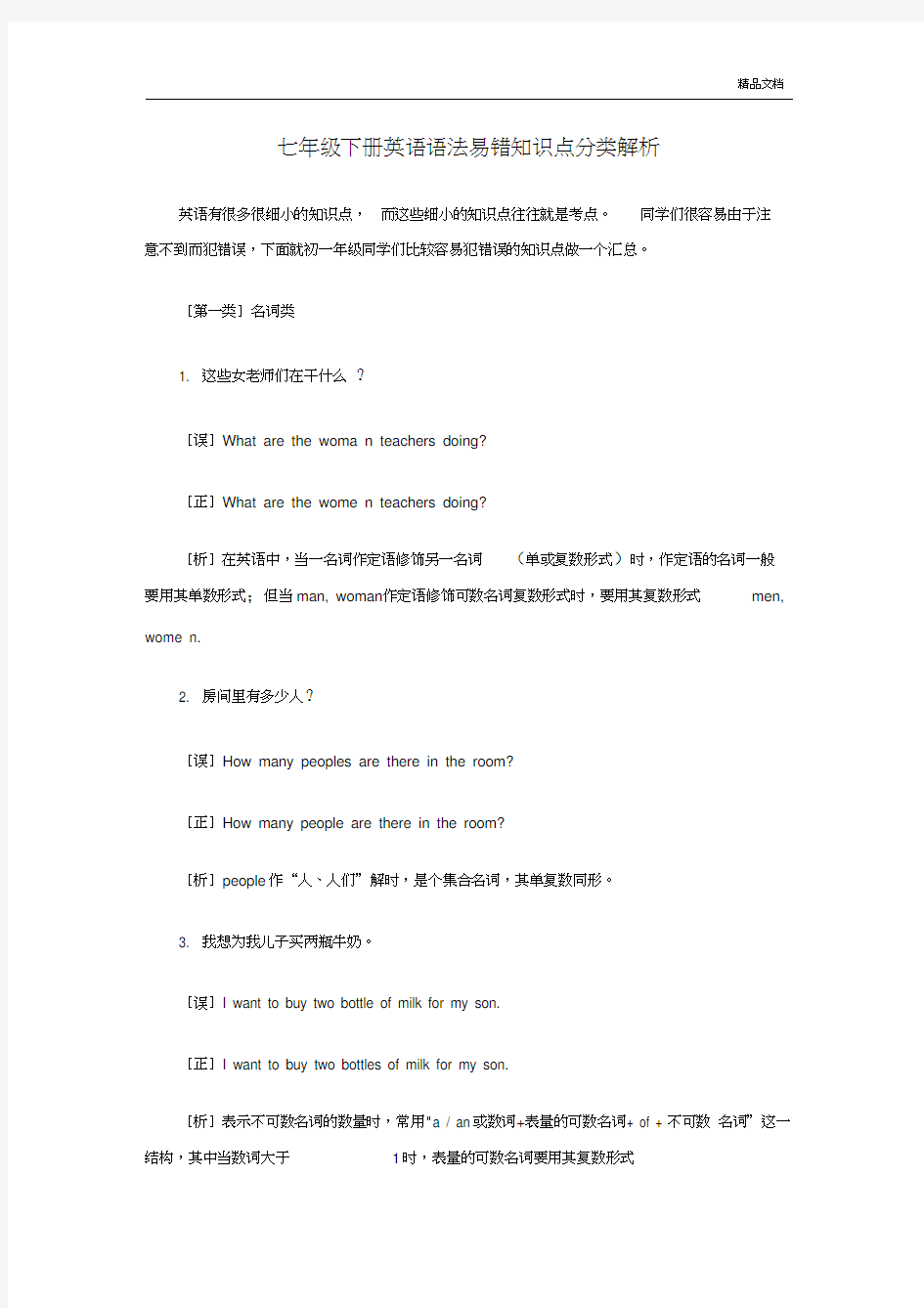七年级下册英语语法易错知识点分类解析


七年级下册英语语法易错知识点分类解析
英语有很多很细小的知识点,而这些细小的知识点往往就是考点。同学们很容易由于注
意不到而犯错误,下面就初一年级同学们比较容易犯错误的知识点做一个汇总。
[第一类]名词类
1. 这些女老师们在干什么?
[误]What are the woma n teachers doing?
[正]What are the wome n teachers doing?
[析]在英语中,当一名词作定语修饰另一名词(单或复数形式)时,作定语的名词一般要用其单数形式;但当man, woman作定语修饰可数名词复数形式时,要用其复数形式men, wome n.
2. 房间里有多少人?
[误]How many peoples are there in the room?
[正]How many people are there in the room?
[析]people作“人、人们”解时,是个集合名词,其单复数同形。
3. 我想为我儿子买两瓶牛奶。
[误]I want to buy two bottle of milk for my son.
[正]I want to buy two bottles of milk for my son.
[析]表示不可数名词的数量时,常用"a / an 或数词+表量的可数名词+ of + 不可数名词”这一结构,其中当数词大于1时,表量的可数名词要用其复数形式
[第二类]动词类
4. 你妹妹通常什么时候去上学?
[误]What time does your sister usually goes to school?
[正]What time does your sister usually go to school?
[析]借助助动词do(或does)构成疑问句或否定句时,句中的谓语动词用其原形。
5. 琳达晚上经常做作业,但今晚她在看电视。
[误]Linda ofte n do her homework in the evening, but this eve ning she watch ing TV.
[正]Linda ofte n does her homework in the eve ning, but this evening she is
watch ing TV.
[析]在初一英语学习阶段,我们接触到了两种主要时态:一般现在时和现在进行时。
一般现在时表示经常的或习惯性的动作,常和ofte n, usually, sometimes 等时间状语连
用。在一般现在时的句子中,若主语是第三人称单数,谓语动词要用其第三人称单数形式。
现在进行时表示现阶段正在进行或发生的动作,现在进行时由be(am / is / are)+vi ng 形式构成。
6. 这双鞋是红色的。
[误]This pair of shoes are red.
[正]This pair of shoes is red.
[析]在shoes, trousers, gloves, glasses 等表示成双成对的衣物或工具名词前用
pair(表计量)修饰时,谓语动词的形式由pair的单复数形式来决定。
[第三类]代词类
7. 这张票是她的,不是我的。
[误]This is hers ticket. It s not my.
[析]1.表示“ 家人”用结构“ the +姓氏复数”;
[正]This is her ticket. It ' s not mine.
[析]物主代词有形容词性物主代词和名词性物主代词之分。形容词性物主代词之后一 定要接名词,而名词性物主代词之后不需接任何词。
8. 吴老师教我们英语。
[误]Miss Wu teaches our En glish.
[正]Miss Wu teaches us En glish.
[析]teach sb. sth.. 中的sb.作teach 的宾语,因此当sb.为人称代词时要用其宾格 形式。 [第四类]介词类
9. 你能找到这个问题的答案吗 ?
[误]Can you find the answer of this question?
[正]Can you find the answer to this question?
[析]英语中用"the answer to
…”表示" .... 的答案"。类似结构还有 the key to the door, the way to the zoo 等。
10. 格林先生星期六上午来这里。
[误]Mr. Green will come here in Sun day evening.
[正]Mr. Gree n will come here on Sun day evening.
[析]表示在上午、下午等时,介词要用
in;而表示在具体的某天上午、下午时,介词
要用on. 11. 那个穿着红裙子的小女孩是我们老师的女儿。 [误]That little girl on a red skirt is our teacher s daughter.
[正]That little girl in a red skirt is our teacher ' s daughter.
[析]用介词表示“穿戴衣物”时,只能用in,其他介词没有此用法。
[第五类]副词类
12. 莉莉,你为什么不回家呢?
[误]Lily, why don ' t you go to home?
[正]Lily, why don ' t you go home?
[析]co
me, go 等后接here, there, home 等地点副词时,地点副词前不加to。
[第六类]连词类
13. 我喜欢语文和英语,但我不喜欢体育和历史。
[误]I like Chinese and English, but I don ' t like P.E. and history.
[正]I like C hinese and English, but I don ' t like P.E. or history.
[析]在肯定句中并列成分之间用and来连接;而在否定句中,并列成分之间的连接需用or。
[第七类]冠词类
14. 乘飞机去北京花了史密斯一家人一个小时。
[误]It takes Smiths a hour to go to Beijing by a plane.
[正]It takes the Smiths an hour to go to Beijing by plane.
2.our —词的第一个字母不发音,它是以元音音素开头的,所以“一小时”要用an hour;
3.用介词by表示“乘坐”某种交通工具时,交通工具名词前不加任何冠词。
[第八类]句法类
15. ――你不是学生吗?一一不,我是学生。
[误] --- Aren' t you a stude nt? ---------- No, I am.
[正] --- Aren' t you a stude nt? ---------- Yes,I am.
[析]对否定疑问句的回答是用Yes还是用No,这取决于实际情况:如果事实是肯定的, 就用Yes表“不”;如果事实是否定的,就用No表“是的”。
2.房间里有多少人?
[误]How many peoples are there in the room?
[正]How many people are there in the room?
[析]people作“人、人们”解时,是个集合名词,其单复数同形。
[析]1.表示“家人”用结构“ the +姓氏复数”;
